Business Decision Making: NPV, Payback Period, and Financial Factors
VerifiedAdded on 2023/01/11
|7
|1315
|69
Essay
AI Summary
This essay examines business decision-making processes, focusing on the application of Net Present Value (NPV) and payback period methods for evaluating investment projects. The analysis is based on a case study of a hotel chain, Xyz Plc, considering two potential projects: a software project and a launderette project. The essay calculates and compares the NPV and payback periods for each project, highlighting the benefits and drawbacks of each method. It concludes that project B is a better option. Furthermore, the essay explores the influence of both financial factors, such as cash flow and taxation, and non-financial factors, including human resources and potential growth opportunities, on the decision-making process. The essay underscores the importance of a comprehensive analysis that incorporates both quantitative and qualitative elements to ensure sound business decisions.

Business Decision
Making
Making
Paraphrase This Document
Need a fresh take? Get an instant paraphrase of this document with our AI Paraphraser
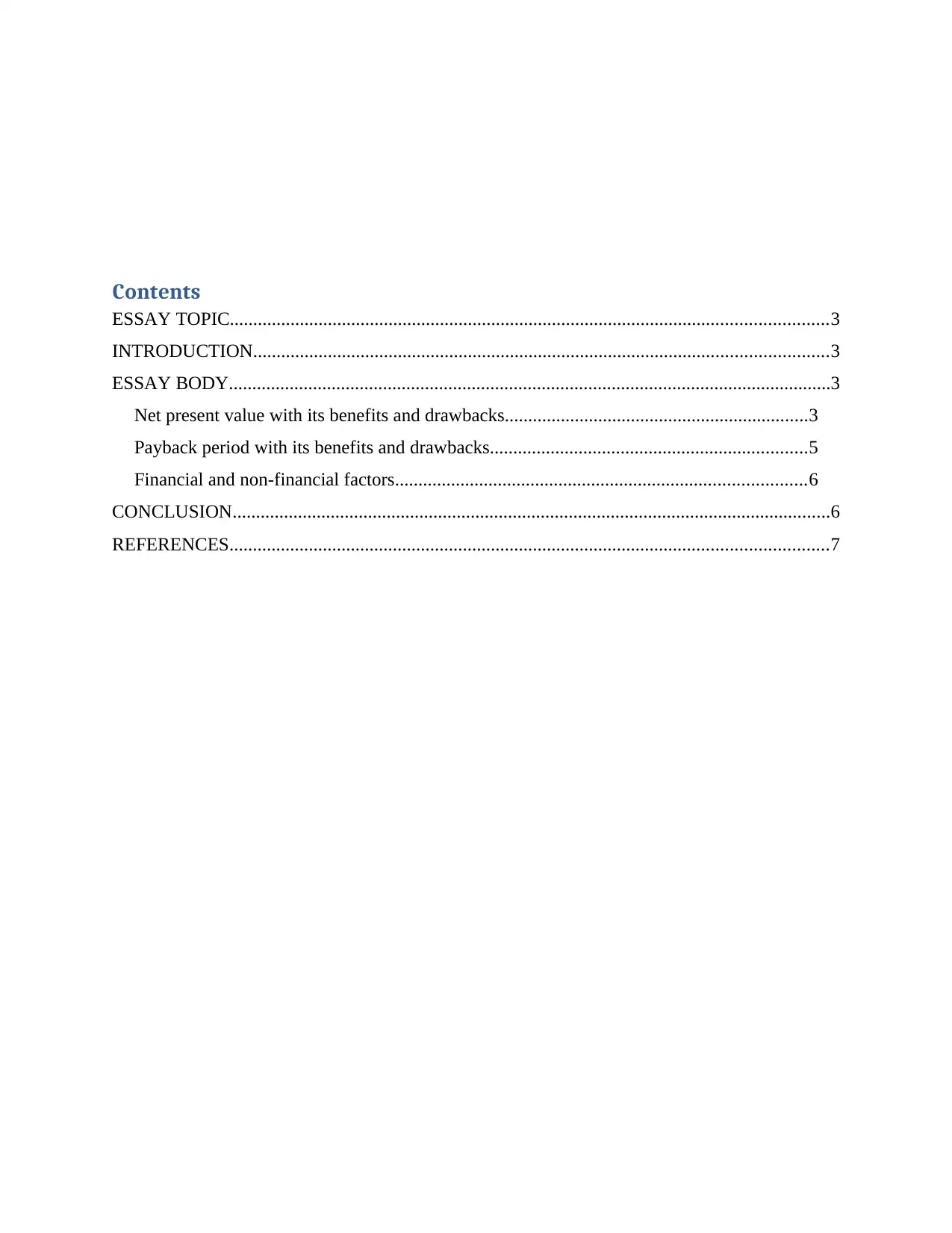
Contents
ESSAY TOPIC................................................................................................................................3
INTRODUCTION...........................................................................................................................3
ESSAY BODY.................................................................................................................................3
Net present value with its benefits and drawbacks.................................................................3
Payback period with its benefits and drawbacks....................................................................5
Financial and non-financial factors........................................................................................6
CONCLUSION................................................................................................................................6
REFERENCES................................................................................................................................7
ESSAY TOPIC................................................................................................................................3
INTRODUCTION...........................................................................................................................3
ESSAY BODY.................................................................................................................................3
Net present value with its benefits and drawbacks.................................................................3
Payback period with its benefits and drawbacks....................................................................5
Financial and non-financial factors........................................................................................6
CONCLUSION................................................................................................................................6
REFERENCES................................................................................................................................7
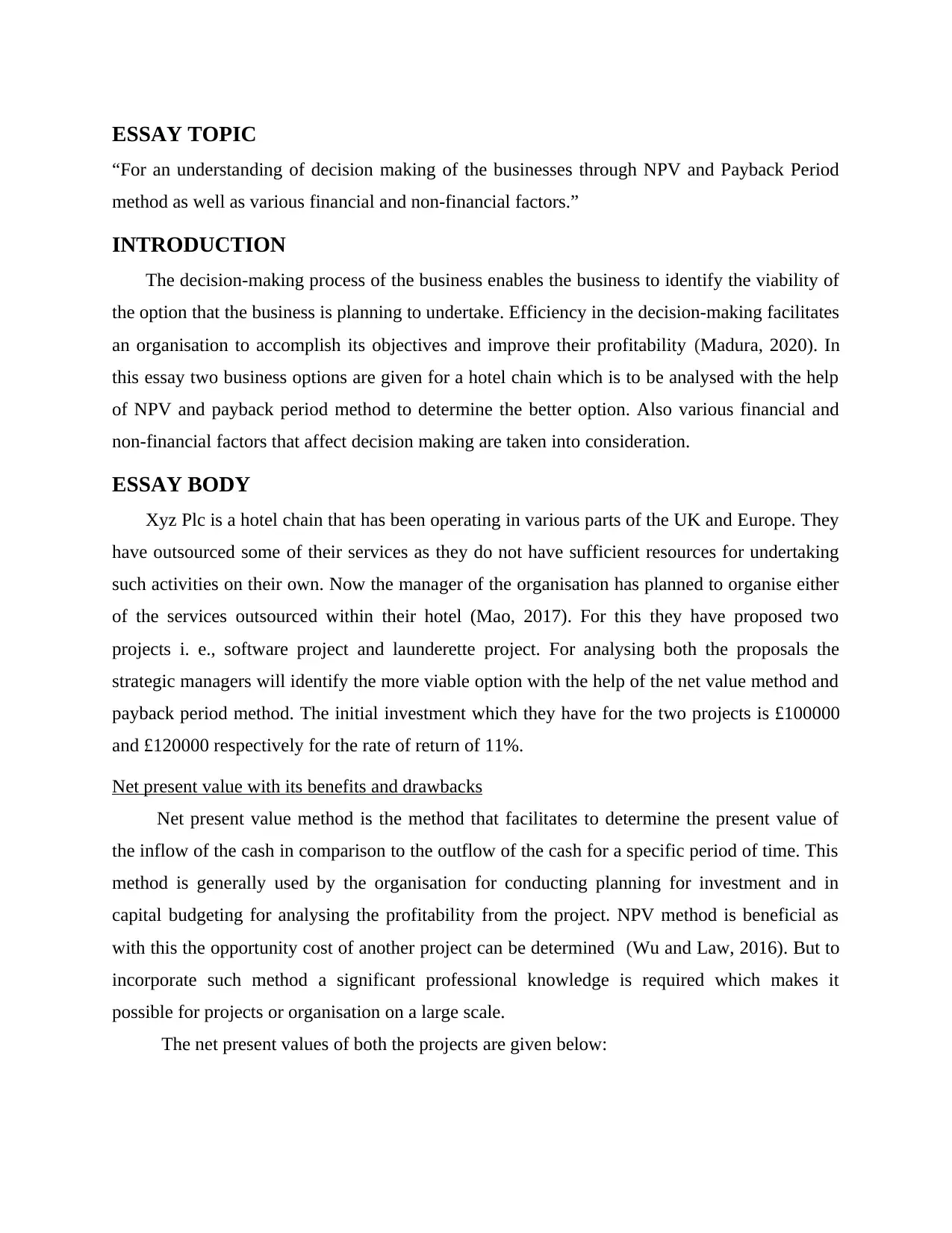
ESSAY TOPIC
“For an understanding of decision making of the businesses through NPV and Payback Period
method as well as various financial and non-financial factors.”
INTRODUCTION
The decision-making process of the business enables the business to identify the viability of
the option that the business is planning to undertake. Efficiency in the decision-making facilitates
an organisation to accomplish its objectives and improve their profitability (Madura, 2020). In
this essay two business options are given for a hotel chain which is to be analysed with the help
of NPV and payback period method to determine the better option. Also various financial and
non-financial factors that affect decision making are taken into consideration.
ESSAY BODY
Xyz Plc is a hotel chain that has been operating in various parts of the UK and Europe. They
have outsourced some of their services as they do not have sufficient resources for undertaking
such activities on their own. Now the manager of the organisation has planned to organise either
of the services outsourced within their hotel (Mao, 2017). For this they have proposed two
projects i. e., software project and launderette project. For analysing both the proposals the
strategic managers will identify the more viable option with the help of the net value method and
payback period method. The initial investment which they have for the two projects is £100000
and £120000 respectively for the rate of return of 11%.
Net present value with its benefits and drawbacks
Net present value method is the method that facilitates to determine the present value of
the inflow of the cash in comparison to the outflow of the cash for a specific period of time. This
method is generally used by the organisation for conducting planning for investment and in
capital budgeting for analysing the profitability from the project. NPV method is beneficial as
with this the opportunity cost of another project can be determined (Wu and Law, 2016). But to
incorporate such method a significant professional knowledge is required which makes it
possible for projects or organisation on a large scale.
The net present values of both the projects are given below:
“For an understanding of decision making of the businesses through NPV and Payback Period
method as well as various financial and non-financial factors.”
INTRODUCTION
The decision-making process of the business enables the business to identify the viability of
the option that the business is planning to undertake. Efficiency in the decision-making facilitates
an organisation to accomplish its objectives and improve their profitability (Madura, 2020). In
this essay two business options are given for a hotel chain which is to be analysed with the help
of NPV and payback period method to determine the better option. Also various financial and
non-financial factors that affect decision making are taken into consideration.
ESSAY BODY
Xyz Plc is a hotel chain that has been operating in various parts of the UK and Europe. They
have outsourced some of their services as they do not have sufficient resources for undertaking
such activities on their own. Now the manager of the organisation has planned to organise either
of the services outsourced within their hotel (Mao, 2017). For this they have proposed two
projects i. e., software project and launderette project. For analysing both the proposals the
strategic managers will identify the more viable option with the help of the net value method and
payback period method. The initial investment which they have for the two projects is £100000
and £120000 respectively for the rate of return of 11%.
Net present value with its benefits and drawbacks
Net present value method is the method that facilitates to determine the present value of
the inflow of the cash in comparison to the outflow of the cash for a specific period of time. This
method is generally used by the organisation for conducting planning for investment and in
capital budgeting for analysing the profitability from the project. NPV method is beneficial as
with this the opportunity cost of another project can be determined (Wu and Law, 2016). But to
incorporate such method a significant professional knowledge is required which makes it
possible for projects or organisation on a large scale.
The net present values of both the projects are given below:
⊘ This is a preview!⊘
Do you want full access?
Subscribe today to unlock all pages.

Trusted by 1+ million students worldwide
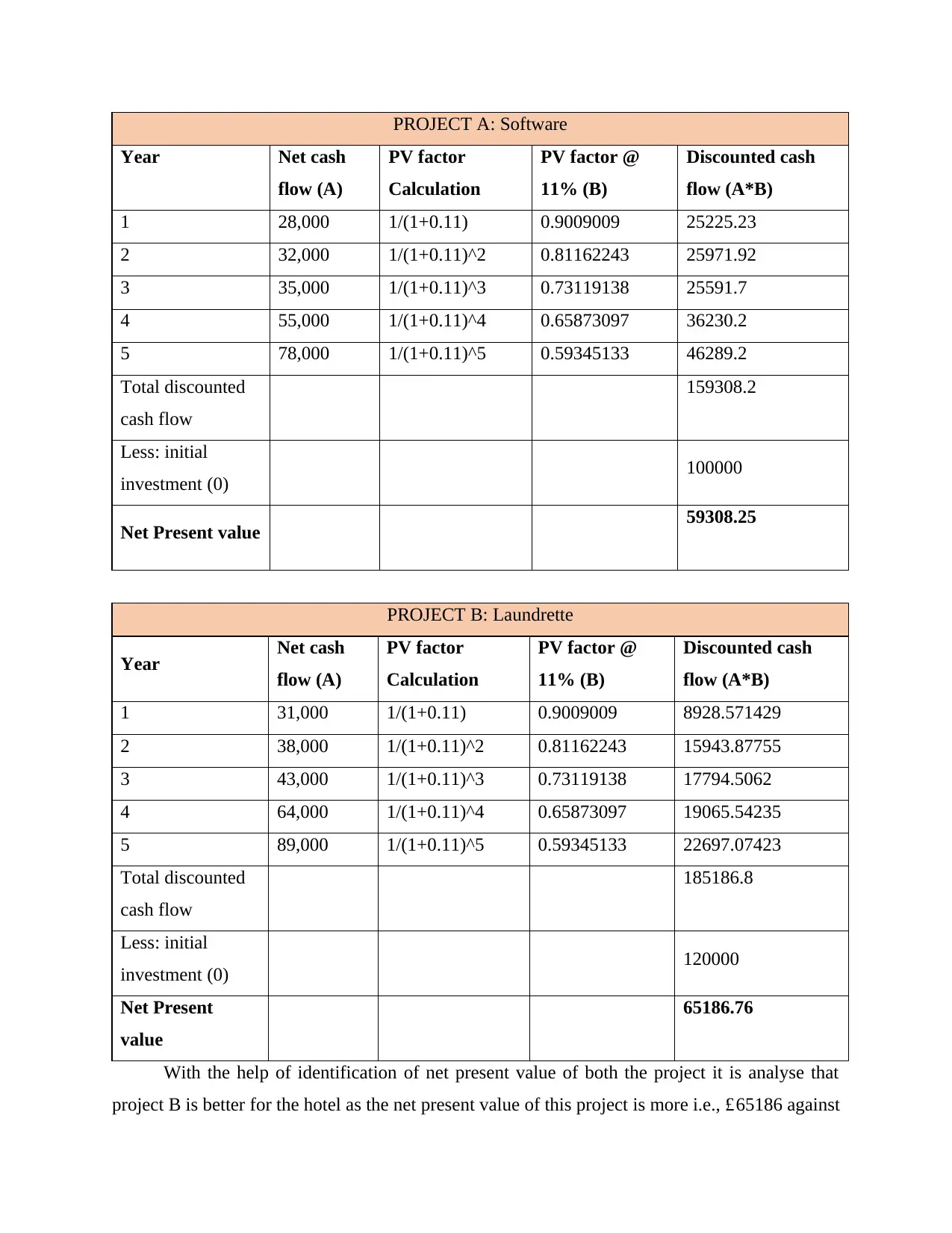
PROJECT A: Software
Year Net cash
flow (A)
PV factor
Calculation
PV factor @
11% (B)
Discounted cash
flow (A*B)
1 28,000 1/(1+0.11) 0.9009009 25225.23
2 32,000 1/(1+0.11)^2 0.81162243 25971.92
3 35,000 1/(1+0.11)^3 0.73119138 25591.7
4 55,000 1/(1+0.11)^4 0.65873097 36230.2
5 78,000 1/(1+0.11)^5 0.59345133 46289.2
Total discounted
cash flow
159308.2
Less: initial
investment (0) 100000
Net Present value 59308.25
PROJECT B: Laundrette
Year Net cash
flow (A)
PV factor
Calculation
PV factor @
11% (B)
Discounted cash
flow (A*B)
1 31,000 1/(1+0.11) 0.9009009 8928.571429
2 38,000 1/(1+0.11)^2 0.81162243 15943.87755
3 43,000 1/(1+0.11)^3 0.73119138 17794.5062
4 64,000 1/(1+0.11)^4 0.65873097 19065.54235
5 89,000 1/(1+0.11)^5 0.59345133 22697.07423
Total discounted
cash flow
185186.8
Less: initial
investment (0) 120000
Net Present
value
65186.76
With the help of identification of net present value of both the project it is analyse that
project B is better for the hotel as the net present value of this project is more i.e., £65186 against
Year Net cash
flow (A)
PV factor
Calculation
PV factor @
11% (B)
Discounted cash
flow (A*B)
1 28,000 1/(1+0.11) 0.9009009 25225.23
2 32,000 1/(1+0.11)^2 0.81162243 25971.92
3 35,000 1/(1+0.11)^3 0.73119138 25591.7
4 55,000 1/(1+0.11)^4 0.65873097 36230.2
5 78,000 1/(1+0.11)^5 0.59345133 46289.2
Total discounted
cash flow
159308.2
Less: initial
investment (0) 100000
Net Present value 59308.25
PROJECT B: Laundrette
Year Net cash
flow (A)
PV factor
Calculation
PV factor @
11% (B)
Discounted cash
flow (A*B)
1 31,000 1/(1+0.11) 0.9009009 8928.571429
2 38,000 1/(1+0.11)^2 0.81162243 15943.87755
3 43,000 1/(1+0.11)^3 0.73119138 17794.5062
4 64,000 1/(1+0.11)^4 0.65873097 19065.54235
5 89,000 1/(1+0.11)^5 0.59345133 22697.07423
Total discounted
cash flow
185186.8
Less: initial
investment (0) 120000
Net Present
value
65186.76
With the help of identification of net present value of both the project it is analyse that
project B is better for the hotel as the net present value of this project is more i.e., £65186 against
Paraphrase This Document
Need a fresh take? Get an instant paraphrase of this document with our AI Paraphraser
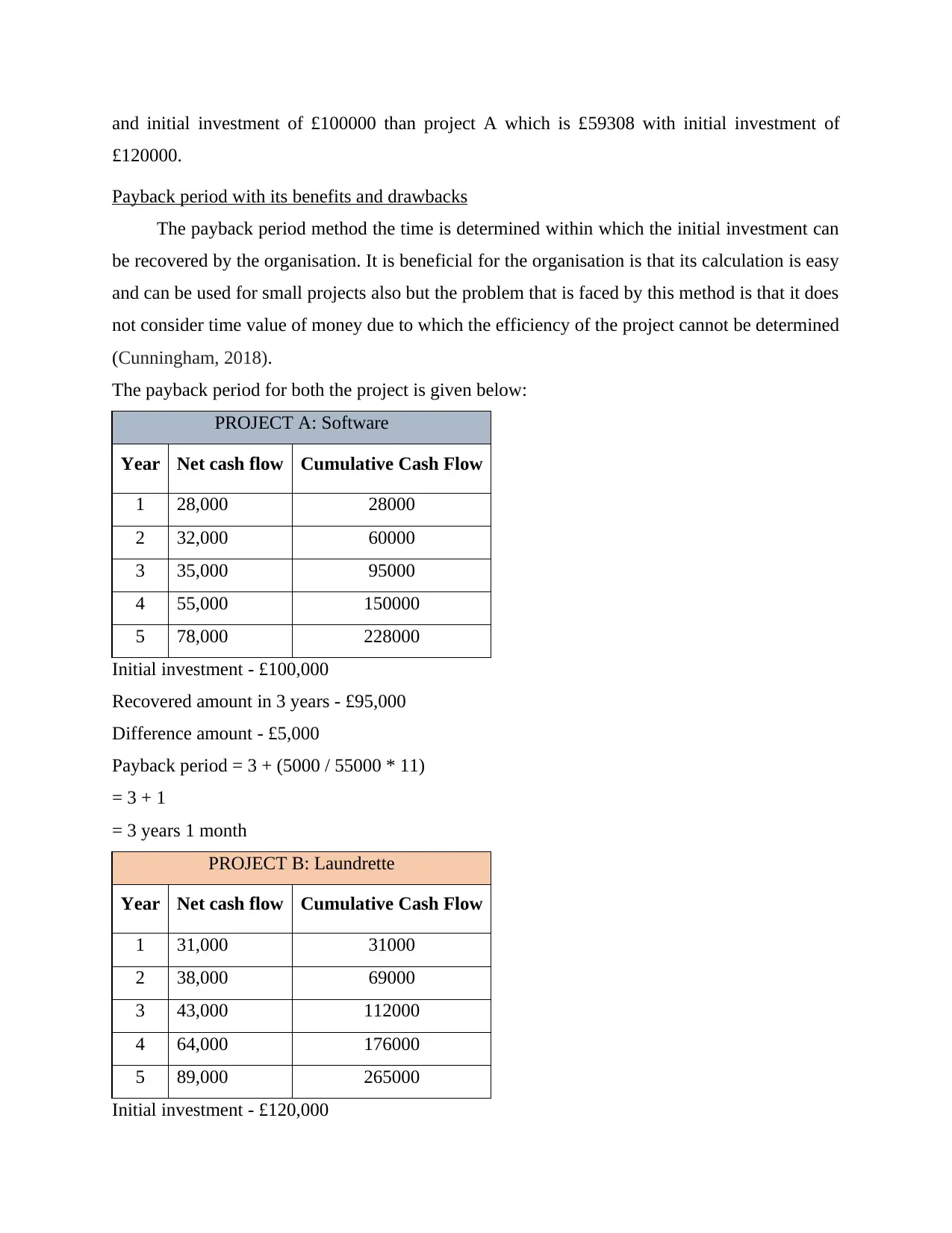
and initial investment of £100000 than project A which is £59308 with initial investment of
£120000.
Payback period with its benefits and drawbacks
The payback period method the time is determined within which the initial investment can
be recovered by the organisation. It is beneficial for the organisation is that its calculation is easy
and can be used for small projects also but the problem that is faced by this method is that it does
not consider time value of money due to which the efficiency of the project cannot be determined
(Cunningham, 2018).
The payback period for both the project is given below:
PROJECT A: Software
Year Net cash flow Cumulative Cash Flow
1 28,000 28000
2 32,000 60000
3 35,000 95000
4 55,000 150000
5 78,000 228000
Initial investment - £100,000
Recovered amount in 3 years - £95,000
Difference amount - £5,000
Payback period = 3 + (5000 / 55000 * 11)
= 3 + 1
= 3 years 1 month
PROJECT B: Laundrette
Year Net cash flow Cumulative Cash Flow
1 31,000 31000
2 38,000 69000
3 43,000 112000
4 64,000 176000
5 89,000 265000
Initial investment - £120,000
£120000.
Payback period with its benefits and drawbacks
The payback period method the time is determined within which the initial investment can
be recovered by the organisation. It is beneficial for the organisation is that its calculation is easy
and can be used for small projects also but the problem that is faced by this method is that it does
not consider time value of money due to which the efficiency of the project cannot be determined
(Cunningham, 2018).
The payback period for both the project is given below:
PROJECT A: Software
Year Net cash flow Cumulative Cash Flow
1 28,000 28000
2 32,000 60000
3 35,000 95000
4 55,000 150000
5 78,000 228000
Initial investment - £100,000
Recovered amount in 3 years - £95,000
Difference amount - £5,000
Payback period = 3 + (5000 / 55000 * 11)
= 3 + 1
= 3 years 1 month
PROJECT B: Laundrette
Year Net cash flow Cumulative Cash Flow
1 31,000 31000
2 38,000 69000
3 43,000 112000
4 64,000 176000
5 89,000 265000
Initial investment - £120,000
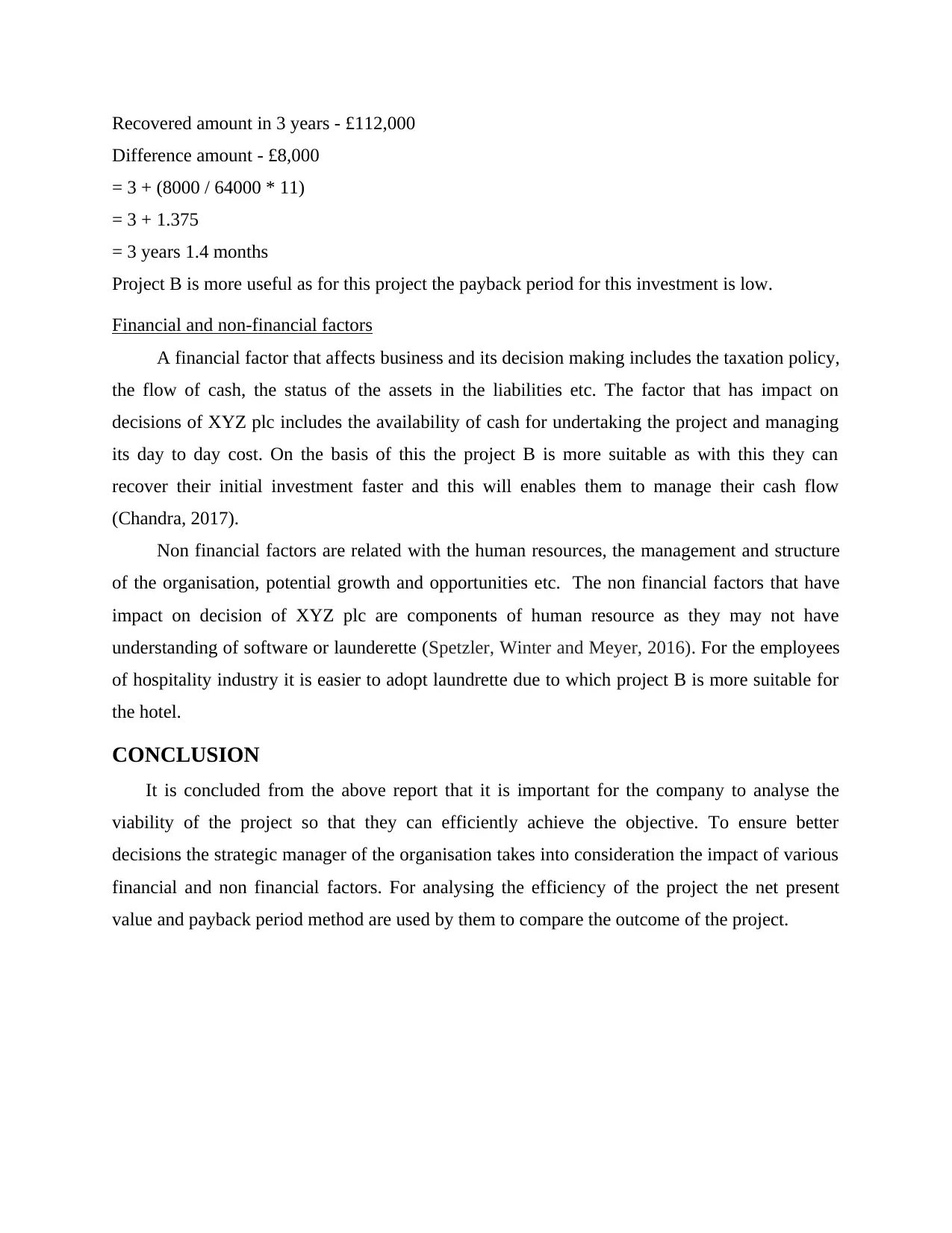
Recovered amount in 3 years - £112,000
Difference amount - £8,000
= 3 + (8000 / 64000 * 11)
= 3 + 1.375
= 3 years 1.4 months
Project B is more useful as for this project the payback period for this investment is low.
Financial and non-financial factors
A financial factor that affects business and its decision making includes the taxation policy,
the flow of cash, the status of the assets in the liabilities etc. The factor that has impact on
decisions of XYZ plc includes the availability of cash for undertaking the project and managing
its day to day cost. On the basis of this the project B is more suitable as with this they can
recover their initial investment faster and this will enables them to manage their cash flow
(Chandra, 2017).
Non financial factors are related with the human resources, the management and structure
of the organisation, potential growth and opportunities etc. The non financial factors that have
impact on decision of XYZ plc are components of human resource as they may not have
understanding of software or launderette (Spetzler, Winter and Meyer, 2016). For the employees
of hospitality industry it is easier to adopt laundrette due to which project B is more suitable for
the hotel.
CONCLUSION
It is concluded from the above report that it is important for the company to analyse the
viability of the project so that they can efficiently achieve the objective. To ensure better
decisions the strategic manager of the organisation takes into consideration the impact of various
financial and non financial factors. For analysing the efficiency of the project the net present
value and payback period method are used by them to compare the outcome of the project.
Difference amount - £8,000
= 3 + (8000 / 64000 * 11)
= 3 + 1.375
= 3 years 1.4 months
Project B is more useful as for this project the payback period for this investment is low.
Financial and non-financial factors
A financial factor that affects business and its decision making includes the taxation policy,
the flow of cash, the status of the assets in the liabilities etc. The factor that has impact on
decisions of XYZ plc includes the availability of cash for undertaking the project and managing
its day to day cost. On the basis of this the project B is more suitable as with this they can
recover their initial investment faster and this will enables them to manage their cash flow
(Chandra, 2017).
Non financial factors are related with the human resources, the management and structure
of the organisation, potential growth and opportunities etc. The non financial factors that have
impact on decision of XYZ plc are components of human resource as they may not have
understanding of software or launderette (Spetzler, Winter and Meyer, 2016). For the employees
of hospitality industry it is easier to adopt laundrette due to which project B is more suitable for
the hotel.
CONCLUSION
It is concluded from the above report that it is important for the company to analyse the
viability of the project so that they can efficiently achieve the objective. To ensure better
decisions the strategic manager of the organisation takes into consideration the impact of various
financial and non financial factors. For analysing the efficiency of the project the net present
value and payback period method are used by them to compare the outcome of the project.
⊘ This is a preview!⊘
Do you want full access?
Subscribe today to unlock all pages.

Trusted by 1+ million students worldwide
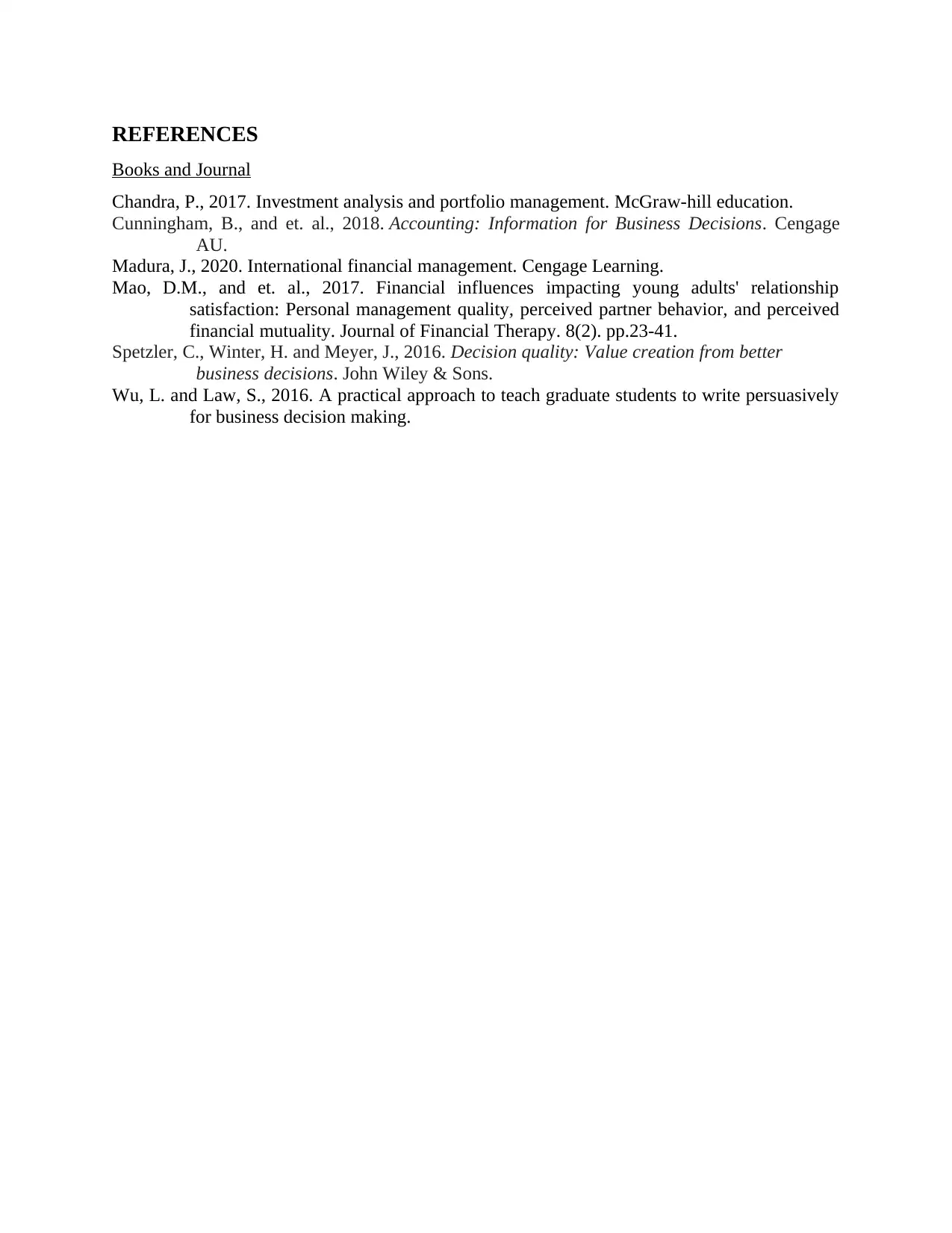
REFERENCES
Books and Journal
Chandra, P., 2017. Investment analysis and portfolio management. McGraw-hill education.
Cunningham, B., and et. al., 2018. Accounting: Information for Business Decisions. Cengage
AU.
Madura, J., 2020. International financial management. Cengage Learning.
Mao, D.M., and et. al., 2017. Financial influences impacting young adults' relationship
satisfaction: Personal management quality, perceived partner behavior, and perceived
financial mutuality. Journal of Financial Therapy. 8(2). pp.23-41.
Spetzler, C., Winter, H. and Meyer, J., 2016. Decision quality: Value creation from better
business decisions. John Wiley & Sons.
Wu, L. and Law, S., 2016. A practical approach to teach graduate students to write persuasively
for business decision making.
Books and Journal
Chandra, P., 2017. Investment analysis and portfolio management. McGraw-hill education.
Cunningham, B., and et. al., 2018. Accounting: Information for Business Decisions. Cengage
AU.
Madura, J., 2020. International financial management. Cengage Learning.
Mao, D.M., and et. al., 2017. Financial influences impacting young adults' relationship
satisfaction: Personal management quality, perceived partner behavior, and perceived
financial mutuality. Journal of Financial Therapy. 8(2). pp.23-41.
Spetzler, C., Winter, H. and Meyer, J., 2016. Decision quality: Value creation from better
business decisions. John Wiley & Sons.
Wu, L. and Law, S., 2016. A practical approach to teach graduate students to write persuasively
for business decision making.
1 out of 7
Related Documents
Your All-in-One AI-Powered Toolkit for Academic Success.
+13062052269
info@desklib.com
Available 24*7 on WhatsApp / Email
![[object Object]](/_next/static/media/star-bottom.7253800d.svg)
Unlock your academic potential
Copyright © 2020–2025 A2Z Services. All Rights Reserved. Developed and managed by ZUCOL.





